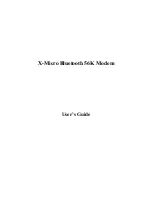
Cermetek Microelectronics, Inc.
High Speed Internet Modem Family
2005 Cermetek Microelectronics, Inc.
Page 3
Document No. 607-0017-01 Revision A (05/05)
CH21XX iModem products utilize TCP/IP, PPP, PAP,
CHAP, SMTP and POP3 internet protocols.
Required External Connections.
The iModem
requires an external RJ-11C jack for the PSTN line
connection. An ITU-T V.24 serial interface is required
when host processor control of the iModem is required
in the specific application. All retrieved emails are
presented to the host system for further processing
and/or retention via the serial interface.
Approvals.
The CH21XX iModem Family is FCC Part
68 approved, UL 1950 and CSA C22.2 950 (Third
Edition) listed and Industry Canada CS-03 approvable.
Physical Dimensions.
The modules are designed for
PCB through-hole mounting and are 1.35” x 1.97” x
0.55” in size.
iMODEM EVALUATION BOARD
Cermetek manufactures a companion evaluation board
that is designed to simplify the hardware connections
required to program the iModem as well as providing a
reliable platform to assist with system level debugging.
Contact Cermetek and ask for the CH21XX iModem
Evaluation Board.
iMODEM CONTROL METHODOLOGIES
The CH2165 iModem receives
@T
®
commands from
the host processor and proceeds to dial up the local
POP, log on to the internet, authenticate and verify the
user ID and password, and either sends or retrieves
email depending on the command received. See Table
1 for a summary of available
@T
®
commands.
The CH2165 offers a variety of internet communication
features ranging from simple one command email
transmission to full send and retrieve email capability.
User Control of the internet communication activity of
the iModem device typically falls into one of the
following basic control strategies:
1. Semiautonomous control, requiring one command to
be issued from the host processor. A pre-stored
message is sent on command.
2. Complete host intervention and supervision requiring
each command to be issued from the host.
Message is constructed and sent in real time.
Semi-Autonomous Control.
This method requires a
minimal amount of host processor intervention and
requires that the DTE serial port be operational. Semi-
autonomous control is a special case of full Host
Supervised Control and relies on the preprogrammed
default internet configuration profile contained within the
iModem. Initiation of an email activity occurs with the
issuance by the host processor to the iModem the
appropriate
@T
®
command to send/retrieve/delete
email. PSTN dial-up, logon, authentication and email
transmission, retrieval, and/or deletion are performed
automatically by the iModem in the same fashion as for
the Fully Autonomous On-Demand control method
described above.
Host Supervised Control.
This method is the most
flexible, but requires issuance by the host processor of
the necessary
@T
®
commands in the required order
from the host processor. When choosing an
implementation scheme utilizing a host processor, the
host controls the iModem by using Cermetek
@T
®
commands. These commands are similar to the
standard Hayes AT command set.
Although the DTE serial port is required to be
operational for this method of control, an additional
feature of this method is the ability of the host to over-
ride the preprogrammed parameters (including the
email message content) by simply entering the
applicable information using the appropriate
@T
®
Command.
Send Email.
To send email messages, the user must
explicitly open the TCP socket connection using the
@TCP
command. This command automatically dials
the specified local access POP phone number,
performs user authentication, establishes a PPP
connection and obtains an IP address.
Once connected to the internet, the user may use one
of two methods to send email messages: use pre-
stored messages contained in resident memory or use
streaming messages obtained in real-time from the
CH2165’s DTE serial I/O port. In either case, multiple
email destination addresses are allowed.
For the case of pre-stored messages, each message is
associated with a user defined message name. The
user enters the
@TD=msgname
command (where
msgname
is the message file name) and the CH2165
sends the email using the SMTP protocol.
For the case of streaming email, the user enters the
@TD=0
command (where
0
is a reserved name and
signals the CH2165 that streaming email is desired).
The CH2165 then sends the appropriate SMTP email
headers and prompts the user to supply the body of the
message. The user presents as many ASCII
characters as desired to the CH2165’s DTE serial port.
When finished, the user must end the streaming input
with a
<CR>.<CR>
. The CH2165 will then terminate
the SMTP message and close the SMTP connection. If
the SMTP inactivity timer limit is exceeded (currently
set at 90 seconds), the CH2165 will automatically
terminate the message and close the SMTP
connection. To end the internet session, the user must
explicitly close the TCP connection and terminate the
PSTN dial-up phone call by entering the
@TCT
command.

































